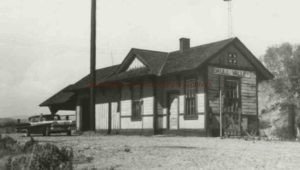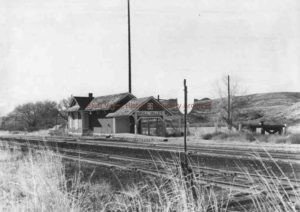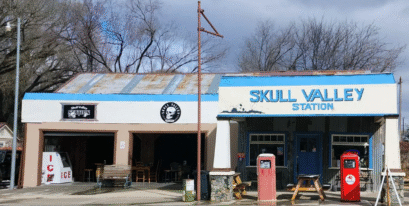
A tour through the Skull Valley Depot Section House Museums and the Community Hall will take people back to the early days of this ranching community. There are pictures of Skull Valley’s earliest families, old-time farming and household implements, and memorabilia about the railroad.
The Skull Valley Railroad Depot was built in 1898 and was moved to its present location in 1970. In 1991, the section house, once home to railroad section managers and their families, was moved to the museum grounds.
The adjacent Skull Valley Community Hall, built in 1916, was facing destruction until the historical society took it over and re-roofed, painted, and furnished it.
Funds from the pie social enable the historical society to continue to maintain these three historical buildings. In recent years, more than 500 people have come to the event for a country afternoon of pie-eating and socializing.
There is an Atchison, Topeka, and Santa Fe railroad depot that dates to 1898, and a 1925 railroad section house filled with artifacts from railroads, mining, ranching, and farming, some dated as far back as the 1800s.


Skull Valley.org is dedicated to the preservation of the local history and artifacts about Skull Valley, Arizona, and the surrounding area and is displayed on this website.
The original Mission that triggered the formation of the Skull Valley Historical Society was to acquire and preserve the 1898 Cherry Creek Depot, built for the Dewey, Arizona Mining Spur.
Mining operations near that location closed down in the early 1920s and the depot was relocated to Skull Valley in 1926 at a new location about ½ mile South of the original Skull Valley 1896 depot. The purpose of this move was both to take advantage of the railroad’s water right coming out of Coughran’s Canyon and to no longer have to pump water used by the steam engines passing through. This move also provided a depot building that was both designed and built to function as a railroad station facility.
Another purpose of Skull Valley.org is to collect, record, illustrate, preserve, and tell the stories of the “Early, and Ongoing” history of this area of Western Yavapai County on the Internet
This includes the major subject categories of Human History, American Indians, Spanish explorers, and European Settlers as well as recent Mexican immigration.
Commercial Developments such as: Mining, Ranching, Farming, and associated Agricultural, Transportation, and Communication Systems. Establishment and changing of markets and cultural centers.
Recording the presence and the changing status of the natural resources of this area. These are strongly influenced by the local geological diversity, the climate, and the extent of human, settlement, developments, and utilization thereof.
